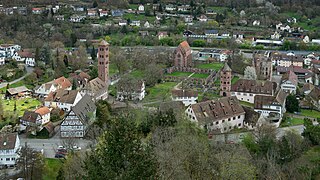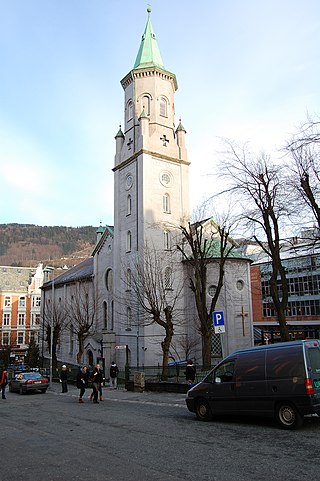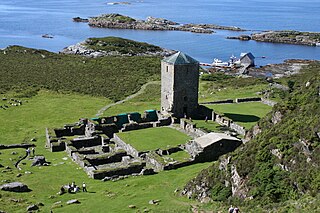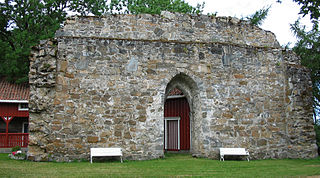
Nidarholm Abbey was a Benedictine monastery located on the island of Munkholmen in Trondheim Fjord on the sea approach to Trondheim, Norway. [1]

Nidarholm Abbey was a Benedictine monastery located on the island of Munkholmen in Trondheim Fjord on the sea approach to Trondheim, Norway. [1]
The monastery was founded either in 1028 by King Canute the Great or in about 1100 by Sigurd Ullstreng (c. 1030 – c. 1100), a vassal of King Magnus Berrføtt. It was dedicated to Saint Benedict and Saint Laurence. The monastery had some connection with the Cluniacs, but it seems that this connection consisted of the introduction of local reforms based on the practices of Cluny, rather than membership of the Cluniac Order and subordination to Cluny as such. The English monk and chronicler Matthew of Paris was asked in 1248, while on a diplomatic mission to King Haakon IV, to supervise a reform of Nidarholm. [2] [3]
The monastery was a powerful and wealthy one, and traded with England, but suffered serious fires in 1210 and 1317, after which it became less prominent. A final fire took place in 1531 shortly before the Reformation. Nidarholm was the last Roman Catholic stronghold in Norway during the Reformation, under Olav Engelbrektsson, Archbishop of Nidaros. His men were besieged in 1537 in Nidarholm by the fleet of Jens Splid (1510–1550), and were eventually forced to surrender. [4]
After 1537 the buildings were abandoned to dereliction, and were used as a quarry for the stone to build the fortresses that later stood on Munkholmen. There are no visible remains of the monastery.
Nidaros, Niðarós or Niðaróss was the medieval name of Trondheim when it was the capital of Norway's first Christian kings. It was named for its position at the mouth of the River Nid.
Magnus Sigurdsson, also known as Magnus the Blind, was King of Norway from 1130 to 1135 and again from 1137 to 1139. His period as king marked the beginning of the civil war era in Norway, which lasted until 1240.

Munkholmen is an islet in the municipality of Trondheim in Trøndelag county, Norway. The 13,000-square-metre (3.2-acre) island sits in the Trondheimsfjord about 1.3 kilometres (0.81 mi) northwest of the island of Brattøra and the mouth of the river Nidelva in the center of the city of Trondheim. The islet has served as a place of execution, a monastery, a fortress, a prison, and a World War II anti-aircraft gun station. Today, Munkholmen is a popular tourist attraction and recreation site.

Cluny Abbey is a former Benedictine monastery in Cluny, Saône-et-Loire, France. It was dedicated to Saint Peter.
The Cluniac Reforms were a series of changes within medieval monasticism of the Western Church focused on restoring the traditional monastic life, encouraging art, and caring for the poor. The movement began within the Benedictine order at Cluny Abbey, founded in 910 by William I, Duke of Aquitaine (875–918). The reforms were largely carried out by Saint Odo and spread throughout France, into England, and through much of Italy, northern Portugal and Spain.

Hirsau Abbey, formerly known as Hirschau Abbey, was once one of the most important Benedictine abbeys of Germany. It is located in the Hirsau borough of Calw on the northern slopes of the Black Forest mountain range, in the present-day state of Baden-Württemberg. In the 11th and 12th century, the monastery was a centre of the Cluniac Reforms, implemented as "Hirsau Reforms" in the German lands by William of Hirsau. The complex was devastated during the War of the Palatine Succession in 1692 and not rebuilt. The ruins served as a quarry for a period of time.

The Catholic Church in Norway is part of the worldwide Catholic Church. As of May 2014, there were over 151,000 registered Catholics in Norway. It is claimed there are many Catholics who are not registered with their personal identification number and who are not reported by the local church; the full number may be as high as 230,000, 70% of whom were born abroad. That constitutes about 5% of the population, making Norway the most Catholic country in Nordic Europe.
Payerne Priory was a Cluniac monastery at Payerne, in Vaud, Switzerland. The monastery is a Swiss heritage site of national significance.

Saint Blaise Abbey was a Benedictine monastery in the village of St. Blasien in the Black Forest in Baden-Württemberg, Germany.

Gorze Abbey was a Benedictine monastery in Gorze in the present arrondissement of Metz, near Metz in Lorraine. It was prominent as the source of a monastic reform movement in the 930s.

Tautra Abbey was a monastery of Cistercian monks founded in the 13th century on the island of Tautra in the Trondheimsfjord in Norway. The island is part of the municipality of Frosta in Trøndelag county, Norway. Tautra Abbey was dissolved during the Reformation in Scandinavia when its lands were passed to the Crown, but the sizeable ruins of the church are still to be seen. The ruins of the former abbey are relatively well preserved and are a favorite tourist destination.

Helgeseter Priory or Elgeseter Priory was a medieval era house of Augustinian Canons in what is now the neighborhood of Elgeseter in Trondheim, Norway.
Gimsøy Abbey was a Benedictine monastery located on the eastern end of the island of Klosterøya at Skien in Telemark, Norway. The island was commonly referred to as Gimsøy or Gjemsø.

Selja Abbey was a Benedictine monastery located on the island of Selja in the municipality of Stad, Vestland, Norway. The island of Selja, which has been formerly known as Sellø or Selø, is located 15 minutes by boat from Selje's mainland.

Rein Abbey was a Roman Catholic religious house for women located in Rissa on the Fosen peninsula to the northwest of Trondheim in Trøndelag, Norway.

Munkeby Abbey was a Cistercian monastery near the village of Okkenhaug in the municipality of Levanger in Trøndelag county, Norway. It was located about 5 kilometres (3.1 mi) east of the town of Levanger. The name "Munkeby" in Norwegian means Place of the Monks. It was closed during the Protestant Reformation. Today the former abbey is the sight of medieval ruins which are managed by the Society for the Preservation of Ancient Norwegian Monuments.
Bakke Abbey was a medieval nunnery in Trondheim in Norway.
St. Canute's Abbey, Odense, a Benedictine monastery, was built to support the pilgrimage centre for the relics of the royal Danish martyr Saint Canute, and was the successor to the priory of St. Mary and St. Alban, Denmark's earliest monastic house. Located in Odense, it was the island of Funen's most important medieval religious institution.

Romainmôtier Priory is a former Cluniac priory in the municipality of Romainmôtier-Envy in the canton of Vaud in Switzerland. The monastery was founded by Romanus of Condat, after whom it was named. It is entered on the Swiss inventory of cultural property of national and regional significance.

Moissac Abbey was a Benedictine and Cluniac monastery in Moissac, Tarn-et-Garonne in south-western France. A number of its medieval buildings survive including the abbey church, which has a famous and important Romanesque sculpture around the entrance.